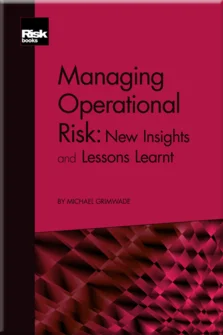Three Historical Spikes in Operational Risk Losses
Introduction
Three Historical Spikes in Operational Risk Losses
First-Order Effects: Transforming Credit Defaults and Market Turmoil into Operational Risk Losses
Second-Order Effects: Transforming Rising Unemployment and Falling Interest Rates into Operational Risk Losses
Conclusions and Root Causes
Regulatory Change: Part of a Perfect Storm
Macroeconomic Threats: Tax, Rising Interest Rates and New Asset Bubbles
New Technology: Changing Business Models and Risk Profiles
Three Horsemen: Societal, Political and Environmental Change
Backtesting to the Mid-1990s and Conclusions
Defining and Cascading Operational Risk Appetites
Aligning Operational Risk Management Frameworks to Appetites
Estimating Exposures to Tail Events
Solutions for a Triumvirate of Seemingly Intractable Problems
Conclusions
Large operational risk losses since the late 1980s have generally been idiosyncratic/random events, but they have spiked at least three times. Worryingly, each spike has been an order of magnitude larger than its predecessor, and each of these three spikes is associated with either the bursting of economic bubbles or the impacts of policy responses to economic trauma, ie:
-
- the six unexpected US-dollar interest-rate hikes in 1994, as the US recovered from an asset bubble at the end of the 1980s and the aftermath of the Savings & Loan crisis;11Between 1986 and 1995 1,043 thrifts with assets of more than US$500 billion failed (about a third of the total number of thrifts), at a cost to US taxpayers of approximately US$124 billion and to the thrift industry of another US$29 billion (see “The Cost of the Savings and Loan Crisis: Truth and Consequences”, DIC Banking Review 13(2), 26–35).
- the bursting of the dotcom bubble in 2001–2; and
- the global financial crisis of 2007, which grew out of a US residential property bubble; almost a decade later, the aftershocks continue to ripple around the world’s economy, like a malevolent Mexican wave. This is illustrated in Figure 1.1
Copyright Infopro Digital Limited. All rights reserved.
As outlined in our terms and conditions, https://www.infopro-digital.com/terms-and-conditions/subscriptions/ (point 2.4), printing is limited to a single copy.
If you would like to purchase additional rights please email info@risk.net
Copyright Infopro Digital Limited. All rights reserved.
You may share this content using our article tools. As outlined in our terms and conditions, https://www.infopro-digital.com/terms-and-conditions/subscriptions/ (clause 2.4), an Authorised User may only make one copy of the materials for their own personal use. You must also comply with the restrictions in clause 2.5.
If you would like to purchase additional rights please email info@risk.net










